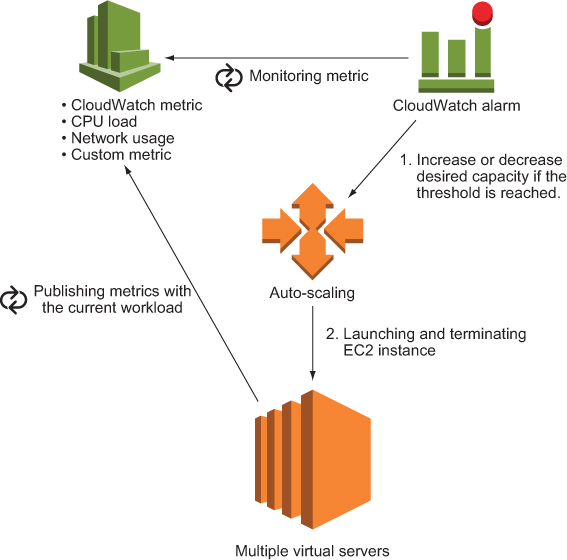AutoScaling and CloudWatch Alarms: Ensuring Scalability for Excellent User Experience
Question
A client who has adopted AWS cloud services would like to ensure that his systems always scale with increasing traffic for a great end-user experience.
I have implemented the same by defining AutoScaling Scale-In & Scale-Out policies & CloudWatch alarms that trigger the AutoScaling.
Which Cloud Architecture Design principles have I implemented here? Select TWO most suitable options.
Answers
Explanations
Click on the arrows to vote for the correct answer
A. B. C. D. E.Answers: B and C.
Looking at the scenario, a good end-user experience is attached to systems being performant with increasing load on them.
A combination of Load balancing & AutoScaling enables a system to handle increase in load by spinning new instances to which the load will be distributed not to saturate resources like CPU & Memory on a single server instance.
For the AutoScaling itself to work efficiently, there needs to be a good monitoring system that can track resource utilization and enable automation.
The scenario combines the Operational Excellence & the Performance Efficiency Architecture design principles.
Option A is incorrect.
This scenario does not describe anything about data encryptions so that this option is not selected.
Option B is CORRECT.
The monitoring mechanism used here is CloudWatch for enabling AutoScaling to happen by tracking resource utilization metrics like CPU and Memory usage.
The Operational Excellence pillar focuses on Monitoring systems that will deliver continuous business value by providing automation, responding to events within the system.
In our scenario, automating the system's Scalability through monitoring will help maintain the desired performance levels.
Option C is CORRECT.
The Performance Efficiency pillar focuses on monitoring the performance of a system.
CloudWatch metrics help monitor a system's performance by using metrics like CPU, Memory, Disk utilization etc..
Automating tasks like AutoScaling using CloudWatch Alarms and defining scaling policies will ensure that the client's performance requirements will always be met with when there is an increase in traffic.
Option D is incorrect.
In spite of using Scale-in & Scale-out policies, I can be benefitted from cutting down idle resource utilization costs.
The scenario deals more with Performance & Operational aspects.
Option E is incorrect.
Least privilege is a security principle which is not mentioned in the question.
Diagrams:
References:
https://aws.amazon.com/blogs/apn/the-5-pillars-of-the-aws-well-architected-framework/
The two Cloud Architecture Design principles that have been implemented in this scenario are:
C. Performance Efficiency - This principle is focused on ensuring that the system is able to deliver the desired level of performance and availability to end-users. By defining AutoScaling Scale-In & Scale-Out policies and CloudWatch alarms that trigger the AutoScaling, the client is able to ensure that his systems always scale with increasing traffic for a great end-user experience. With the help of AutoScaling, the system can automatically adjust its capacity to maintain steady, predictable performance at the lowest possible cost.
D. Cost Optimization - This principle is focused on optimizing costs without sacrificing performance or functionality. By implementing AutoScaling policies and CloudWatch alarms, the client can optimize the costs of his AWS infrastructure. When the traffic is low, the system can automatically reduce the number of instances to save costs, and when the traffic is high, the system can increase the number of instances to maintain performance. This results in cost savings as the client pays only for the resources he needs, and the system can handle sudden spikes in traffic without the need for manual intervention.
A brief explanation of the other options:
A. Encryption - Encryption is a security principle that ensures data is protected while in transit or at rest. While encryption may be important for data protection in an AWS environment, it is not relevant to the scenario described in the question.
B. Operational Excellence - This principle is focused on ensuring that systems are reliable, efficient, and easy to operate. While the implementation of AutoScaling policies and CloudWatch alarms can contribute to operational excellence, this principle is more broadly focused on ensuring that the systems are well-architected, monitored, and maintained over time.
E. Least privilege - This principle is focused on ensuring that access to resources is restricted to only those who need it to perform their jobs. While least privilege is an important security principle in AWS, it is not relevant to the scenario described in the question.